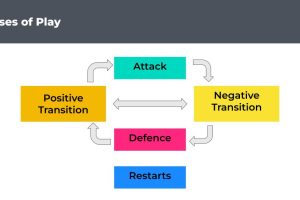Soccer Pre-Game Warm Up: A Comprehensive Guide for Optimal Performance
Soccer is a physically demanding sport that requires a lot of running, jumping, and sudden changes of direction. To prevent injuries and improve performance, it’s important for players to warm up properly before a game. A good warm-up routine can help players prepare mentally and physically for the upcoming match, increase muscular temperature, improve flexibility, promote concentration, elevate motivation, and reduce the risk of injuries.
One of the most common injuries in soccer is hamstring strains, which can be caused by a lack of warm-up or poor technique. To prevent hamstring strains and other injuries, it’s recommended to perform a dynamic warm-up that includes exercises that mimic the movements and demands of soccer. Dynamic stretching, such as leg swings, lunges, and high knees, can help increase blood flow to the muscles and prepare them for the upcoming activity.
There are many different soccer warm-up drills that coaches and players can use to improve their performance and reduce the risk of injuries. The type of warm-up routine will depend on various factors, such as the age of the players, the intensity of the game, and the weather conditions. It’s also important to take breaks and drink water during the warm-up to avoid dehydration and fatigue. By incorporating a well-designed warm-up routine into their training, soccer players can improve their performance, reduce the risk of injuries, and motivate themselves for the upcoming game.
Why a Pre-Game Warm Up is Important
Warming up before a soccer game is crucial for many reasons. It helps prepare the body for the physical demands of the game, reduces the risk of injury, and improves performance.
When a player engages in a pre-game warm up, it increases their muscular temperature, which is essential for optimal performance. The warm-up also improves flexibility and mobility, which is necessary for movements such as kicking, running, and jumping. Additionally, it promotes concentration and elevates motivation, which can have a positive impact on a player’s performance.
One of the most significant benefits of a pre-game warm up is injury prevention. According to a study published in the British Journal of Sports Medicine, warming up before a game can reduce the risk of injury by up to 33%. Injuries such as hamstring strains and other muscle injuries are prevalent in soccer, and a proper warm-up can help prevent them.
Moreover, a pre-game warm up can help players mentally prepare for the game. It can help them focus and get into the right mindset, which is crucial for success. It can also help players get used to the field conditions, which can vary depending on the weather and other factors.
Overall, a pre-game warm up is an essential component of soccer training. It helps prepare the body and mind for the game, reduces the risk of injury, and improves performance. Players and coaches should take it seriously and make sure to allocate enough time for it before each game.
Components of a Soccer Pre-Game Warm Up
Cardiovascular Exercise
One of the essential components of a soccer pre-game warm-up is cardiovascular exercise. This type of exercise helps increase heart rate, blood flow, and body temperature, which prepares the body for physical activity. Examples of cardiovascular exercises include jogging, running, and jumping jacks. These exercises should be performed for at least 5-10 minutes to ensure that the body is adequately warmed up.
Dynamic Stretching
Dynamic stretching is another crucial component of a soccer pre-game warm-up. Unlike static stretching, which involves holding a position for an extended period, dynamic stretching involves moving the body through a range of motion. This type of stretching helps improve flexibility, mobility, and range of motion, which can help prevent injuries such as hamstring strains. Examples of dynamic stretching exercises include walking lunges, high knees, and butt kicks.
Soccer-Specific Drills
The final component of a soccer pre-game warm-up is soccer-specific drills. These drills help players prepare for the specific movements and skills required during a soccer game. Examples of soccer-specific drills include dribbling around cones, passing drills, and small-sided games. These drills should be performed for at least 10-15 minutes to ensure that players are adequately prepared for the game.
Overall, a soccer pre-game warm-up should consist of cardiovascular exercise, dynamic stretching, and soccer-specific drills. This type of warm-up can help prevent injuries, improve performance, and prepare players for the physical demands of a soccer game.
Cardiovascular Exercise
Cardiovascular exercise is an essential part of any soccer pre-game warm-up routine. It helps to increase the heart rate and blood flow to the muscles, preparing them for the intense physical demands of the sport. It also helps to elevate the body’s core temperature, which is crucial for injury prevention and optimal performance.
The type of cardiovascular exercise that is best for soccer warm-ups is low-intensity aerobic exercise. This can include activities such as jogging, jumping jacks, or jump rope. It is important to gradually increase the intensity of the exercise to avoid injury and ensure that the muscles are properly warmed up.
Age and intensity of the warm-up should be taken into consideration. Younger players and those who are less fit may require a longer warm-up period, while older players may need a shorter warm-up with less intensity. It is important to take breaks and stay hydrated during the warm-up to prevent fatigue and dehydration.
Water is crucial for staying hydrated during the warm-up. It is recommended to drink at least 16 ounces of water two hours before the game and 8-10 ounces of water every 10-20 minutes during the warm-up. Dehydration can lead to fatigue, decreased performance, and even injury.
Cardiovascular exercise can also help prevent hamstring strains, which are a common injury in soccer. A proper warm-up routine that includes low-intensity aerobic exercise can help to prevent these types of injuries by preparing the muscles and increasing blood flow to the area.
Overall, cardiovascular exercise is an important component of any soccer pre-game warm-up routine. It helps to prepare the body for the physical demands of the sport, prevent injuries, and optimize performance.
Dynamic Stretching
Dynamic stretching is an essential part of any soccer warm-up routine. It involves active movements that help to increase blood flow, improve flexibility, and prepare the body for physical activity. Dynamic stretching is particularly effective in reducing the risk of hamstring strains, which are a common injury in soccer.
Some examples of dynamic stretches that can be incorporated into a soccer warm-up routine include:
- Walking lunges
- High knees
- Butt kicks
- Leg swings
- Side shuffles
- Skipping
It’s important to note that dynamic stretching should be performed after a brief period of low-level aerobic activity, such as jogging or jumping jacks. This helps to further increase blood flow and prepare the body for more intense physical activity.
In addition to improving flexibility and reducing the risk of injury, dynamic stretching can also help to improve performance on the field. By increasing blood flow and warming up the muscles, dynamic stretching can help players to react more quickly and move more efficiently during the game.
Overall, incorporating dynamic stretching into a soccer warm-up routine is essential for injury prevention, improving flexibility, and optimizing performance on the field.
Soccer-Specific Drills
When it comes to warming up for a soccer game, there are specific drills that can help players prepare for the demands of the sport. These drills aim to improve agility, coordination, balance, and speed while also reducing the risk of injury.
One common drill is the cone drill, which involves setting up cones in various patterns and having players dribble the ball through them. This helps improve ball control and footwork while also getting players moving and ready for the game.
Another drill is the slalom run, which involves setting up cones in a straight line and having players weave in and out of them while dribbling the ball. This helps improve agility and coordination while also getting players warmed up for the game.
For injury prevention, hamstring strains are a common concern in soccer. To help prevent these, players can do hamstring stretches as part of their warm-up routine. This involves stretching the hamstring muscles by bending forward and reaching for the toes or using a resistance band to stretch the muscles.
Overall, incorporating soccer-specific drills into a warm-up routine can help players prepare for the demands of the sport and reduce the risk of injury. By focusing on agility, coordination, balance, and speed, players can improve their performance on the field and stay safe while doing so.
Conclusion
The warm-up is a critical part of any soccer game. It helps players physically and mentally prepare for the game ahead. A proper warm-up routine can reduce the risk of injury and improve performance on the field.
There are many different warm-up drills and exercises that can be used to prepare for a soccer game. Some of the most effective drills include dynamic stretching, ball drills, and passing exercises. These drills can help players improve their flexibility, coordination, and ball control skills.
It is important to note that the warm-up routine should be tailored to the specific needs of the team and the individual players. Coaches should take into account the age, skill level, and physical condition of their players when designing a warm-up routine. Additionally, the warm-up routine should be adjusted based on the weather conditions and the time of day.
Overall, the warm-up is an essential component of any soccer game. It helps players mentally and physically prepare for the game ahead, reduces the risk of injury, and improves performance on the field. By incorporating a variety of warm-up drills and exercises, coaches can ensure that their players are ready to play their best game.








